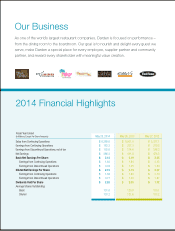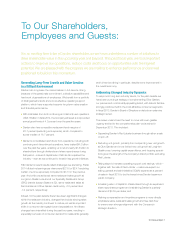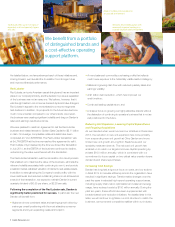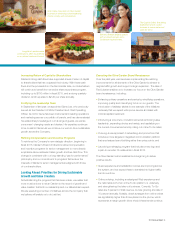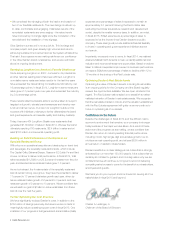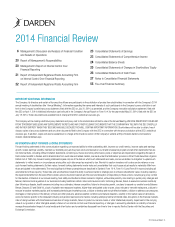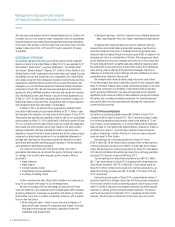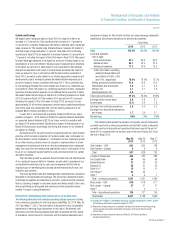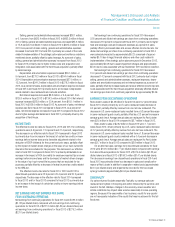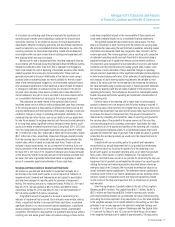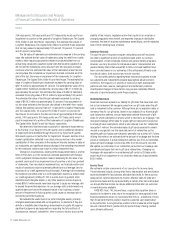Red Lobster 2014 Annual Report Download - page 4
Download and view the complete annual report
Please find page 4 of the 2014 Red Lobster annual report below. You can navigate through the pages in the report by either clicking on the pages listed below, or by using the keyword search tool below to find specific information within the annual report.
2 Darden Restaurants, Inc.
We benefit from a portfolio
of distinguished brands and
a cost-effective operating
support platform.
Eddie V’s offers prime seafood in
an upscale environment.
Seasons 52 provides guests with
seasonally inspired cooking in a
casually sophisticated atmosphere.
Yardhouse offers up to 140 taps of
imported, craft and specialty lagers
and ales.
As detailed below, we have advanced each of these initiatives and,
looking forward, we have laid the foundation for a stronger future
and improved financial performance.
Red Lobster
Red Lobster, an iconic American casual dining brand, has an important
place in our Company’s history, and the decision to pursue a separation
of the business was not an easy one. We believe, however, that it
was the right decision. As consumer demand dynamics have changed,
Red Lobster’s appeal to the most attractive consumer segments
had declined. In addition, its prospects for the future have become
much more uncertain compared to our other brands. As a result,
the business was creating significant volatility and drag on Darden’s
sales and earnings results as a whole.
We were pleased to reach an agreement to sell the Red Lobster
business and related assets to Golden Gate Capital for $2.11 billion
in cash. On average, comparable restaurant deals have been
completed at 7.9x LTM EBITDA. The Red Lobster transaction was
at 9x LTM EBITDA at the time we reached the agreement to sell it.
That multiple only increased by the time we closed the transaction
in July 2014, as the EBITDA of the business continued to decline,
underscoring the value we achieved with the transaction.
The Red Lobster transaction was the culmination of a robust process
that enabled us to maximize the value of the business, eliminate the
risks and volatility associated with continuing to own it, and provide
a realistic market-validated valuation of Darden’s real estate assets.
In addition to strengthening the Company’s credit profile, with the
lower debt levels and reduced outstanding share count achieved as
a result of the transaction, we expect to maintain Darden’s current
quarterly dividend of $0.55 per share, or $2.20 annually.
Following the completion of the Red Lobster sale, Darden is
significantly better positioned for success. In particular, the new
Darden will benefit from:
• Higher and more consistent sales and earnings growth driven by
a stronger overall positioning with the most attractive consumer
segments and by an expanding restaurant footprint;
• A more balanced commodity purchasing profile that reflects
much lower exposure to the historically volatile seafood category;
• Stable and growing cash flow with reduced quarterly sales and
earnings volatility;
• A $1 billion debt reduction, which has improved our
credit metrics;
• Continued leading capital return; and
• A sharper focus on growing our highly attractive brands without
the distraction of continuing to operate a business that is not as
well positioned for the future.
Reducing Unit Expansion, Lowering Capital Expenditures
and Forgoing Acquisitions
As we intended when we announced our initiatives in December
2013, the reduction in new unit expansion has come primarily
from suspending new unit growth at Olive Garden and more
limited new unit growth at LongHorn Steakhouse and our
specialty restaurant brands. The reduced unit growth has
enabled us to reach our target and lower capital spending by
at least $100 million annually, which is consistent with our
commitment to focus capital on two critical value creation levers:
dividends and share repurchases.
Increasing Cost Savings
Darden has long had a rigorous focus on costs, and our actions
in fiscal 2014 to increase efficiency across the organization have
resulted in significant savings. Transformative changes over the
past five years in selected high-spend operating support areas,
including supply chain, labor optimization and water and energy
usage, have reduced costs by $150 million annually. During the
past two years, these efforts have been supplemented with
broader-based cost-reduction initiatives. As detailed later in this
letter, we will continue to rightsize our cost structure to match the
business, consumer and competitive realities within our industry.


